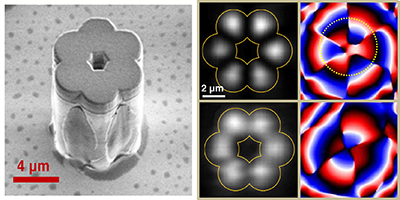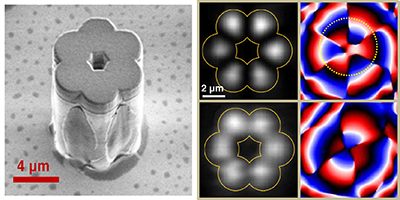Spin-Orbit-Coupled Photons
Spin-orbit coupling—the interaction between electron motion and spin—is behind many unusual forms of electronic behavior, such as the surface-confined currents in topological insulators. Researchers have induced a similar spin-orbit coupling in photons confined to a set of microcavities connected in a hexagonal-ring pattern. The photons orbit around this photonic “molecule” in different ways depending on their polarization (or spin), providing a potential model for studying spin-orbit-coupling effects occurring in other systems.
One of the earliest observations of spin-orbit coupling was in the fine structure in atomic spectra. Certain atomic energy levels are split into two lines because an electron’s orbit around the nucleus depends on the electron’s spin. Alberto Amo from the Laboratory of Photonics and Nanostructure, France, and his colleagues wanted to implement an analogous spin-dependent effect in photons orbiting around a microstructure.
To build this microstructure, the team etched out six small cylinders from a semiconductor microcavity and combined these “micropillars” into a hexagonal ring. Photons confined to one micropillar can excite an electron-hole pair, creating a “polariton” quasiparticle. These polaritons can tunnel from one micropillar to the next, but this motion is more likely for photons with polarization perpendicular to the pillar-pillar boundary so that more of the electric field penetrates into the neighboring micropillar. Calculations show that this spin-orbit coupling should cause a splitting in the polariton energy levels, but it’s too small to be seen. However, Amo and his colleagues were able to measure a polarization pattern in the light that escapes the microstructure, which would only arise in the presence of spin-orbit coupling. The authors expect that many of their photonic molecules could be combined into larger lattice structures, in which the movement of photons could mimic that of electrons in topological insulators.
This research is published in Physical Review X.
–Michael Schirber





